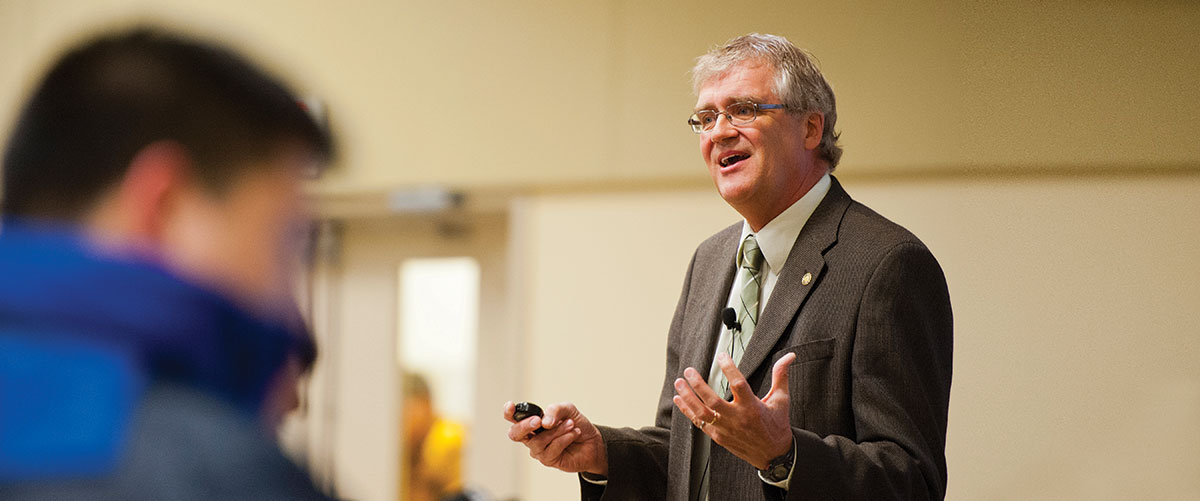
Gordon Winkel, inaugural director of the David and Joan Lynch School of Engineering Safety and Risk Management
Train derailments. Oil spills. Building collapses.
For Gordon Winkel, the first director of the new David and Joan Lynch School of Engineering Safety and Risk Management, ensuring engineering students graduate with a grounding in safety and risk management is key to preventing such disasters.
The school - a first in Canada - builds on 25 years of ESRM teaching, research and outreach at the University of Alberta's Faculty of Engineering. The aim is to ensure every graduate will become an engineer whose decision-making considers high public expectations regarding risk management, from the design of an intersection to plans for a sprawling refinery. Their work will protect communities, infrastructure, livelihoods and people.
With the help of more than $5 million from 59 individual and 19 corporate donors, more engineering students are getting an ESRM education. And they are getting it largely from industry stakeholders such as Ledcor, a global construction company with extensive experience in large infrastructure projects. Ledcor's executive president Tom Lassu, '92 BSc(CivEng), is a strong Lynch School proponent.
"When I graduated, it was accepted that there'd be a certain number of fatalities in oil and gas," Lassu says. "Now if there's an incident, we ask, 'What was our role? How, as leaders, did we contribute? How could this have been avoided?'" The Lynch School, he says, is a means to entrench ESRM so it becomes "part of the fabric of being an engineer."
Chris Coles, '88 BSc(PetEng), '93 MEng, vice-president of manufacturing with Cenovus Energy and a lecturer at the school, concurs. "If you leave the program with curiosity, with the ability to ask the right questions, you'll understand risk so you don't have to learn it on the job," he says. "The Lynch School builds it into an engineer's DNA." And there are financial benefits. "There is a strong correlation between a company's safety and profitability. They are so married."
Winkel, '77 BSc(MechEng), '79 MEng, is keen to see "the ripple effects of the Lynch School," the overall improvements to engineering design and practices that will spread across industries and jurisdictions-even around the world-with future cohorts of U of A engineers. He brings 30-plus years' experience in industry, most recently as vice-president of Syncrude Canada. He joined the U of A in 2010 as chair and industrial professor for safety and risk management.
Winkel points to two U of A mining engineering students who finished first in the ESRM portion of the 2016 Canadian Mining Games with a score of 95 per cent, far ahead of the second-place finishers.
"All the judges were very impressed with the content of our presentation. Specifically, we were able to provide quantitative reasoning in order to formulate reasonable solutions, where other schools were unable to," the students wrote to their ESRM professor John Cocchio. "We truly believe that the Engg 404 course was the root cause of our success in this competition." As they launch their careers, they bring ESRM proficiency into their first engineering positions.
To start the ripple effect and create a culture of safety built into every graduate, the U of A aims to establish a $15-million endowment to sustain and increase the impact of the Lynch School, named in honour of the faculty's former dean David Lynch and his wife, Joan. David Lynch, during his 21 years as engineering dean, made the U of A a leader in engineering safety and risk management.
Earnings from the endowment will make it possible to recruit more people to teach, research and develop ESRM courses and programs. It will also support the engagement of speakers and fund student projects.
"Safety and risk management will increasingly become part of the fabric of how engineers do their work," Winkel says, "and the University of Alberta will be a leader in providing this core competency to students."